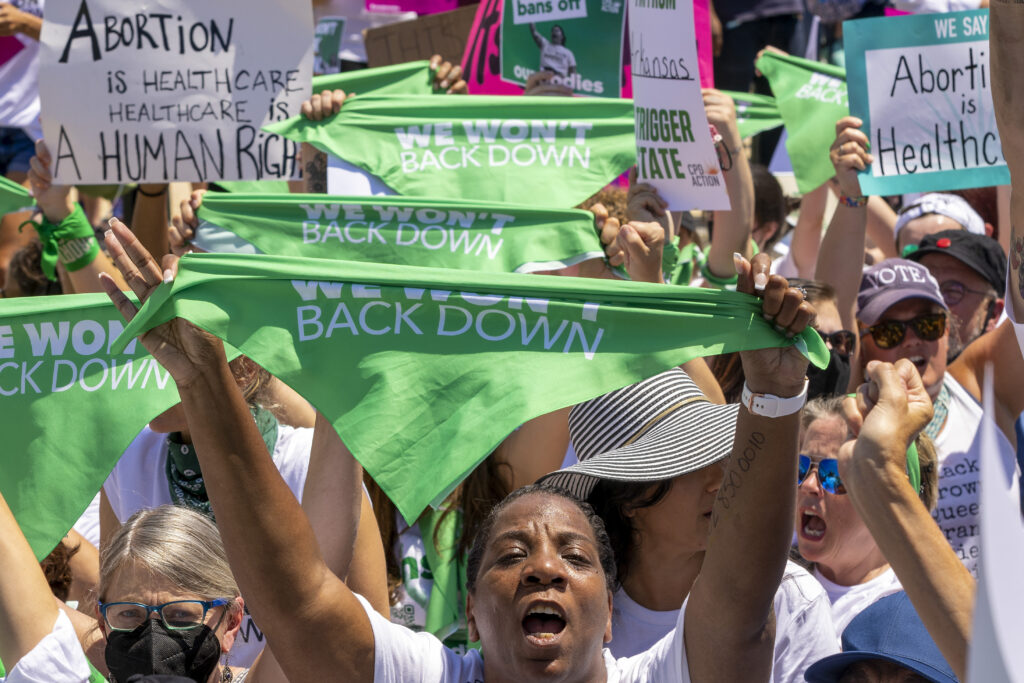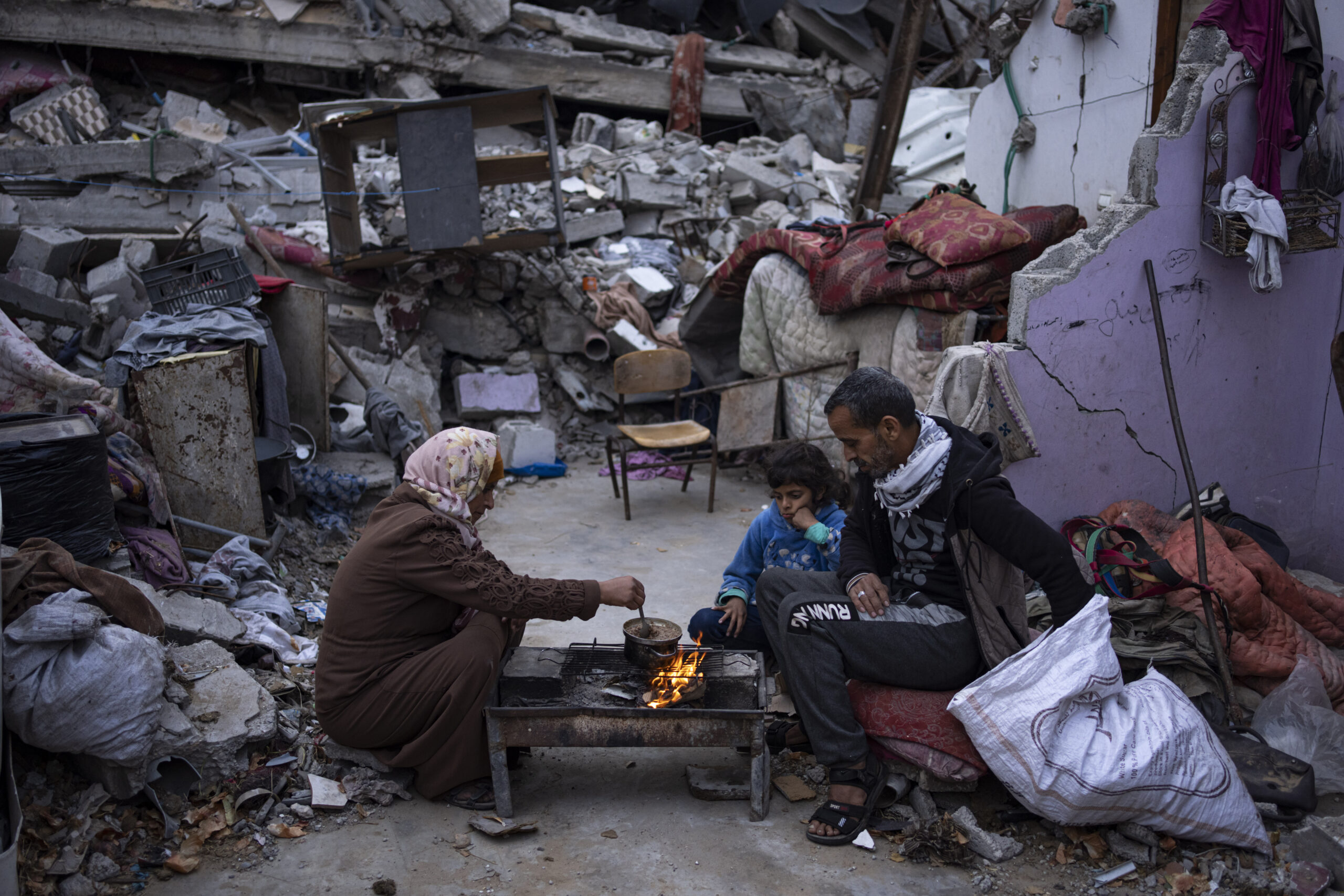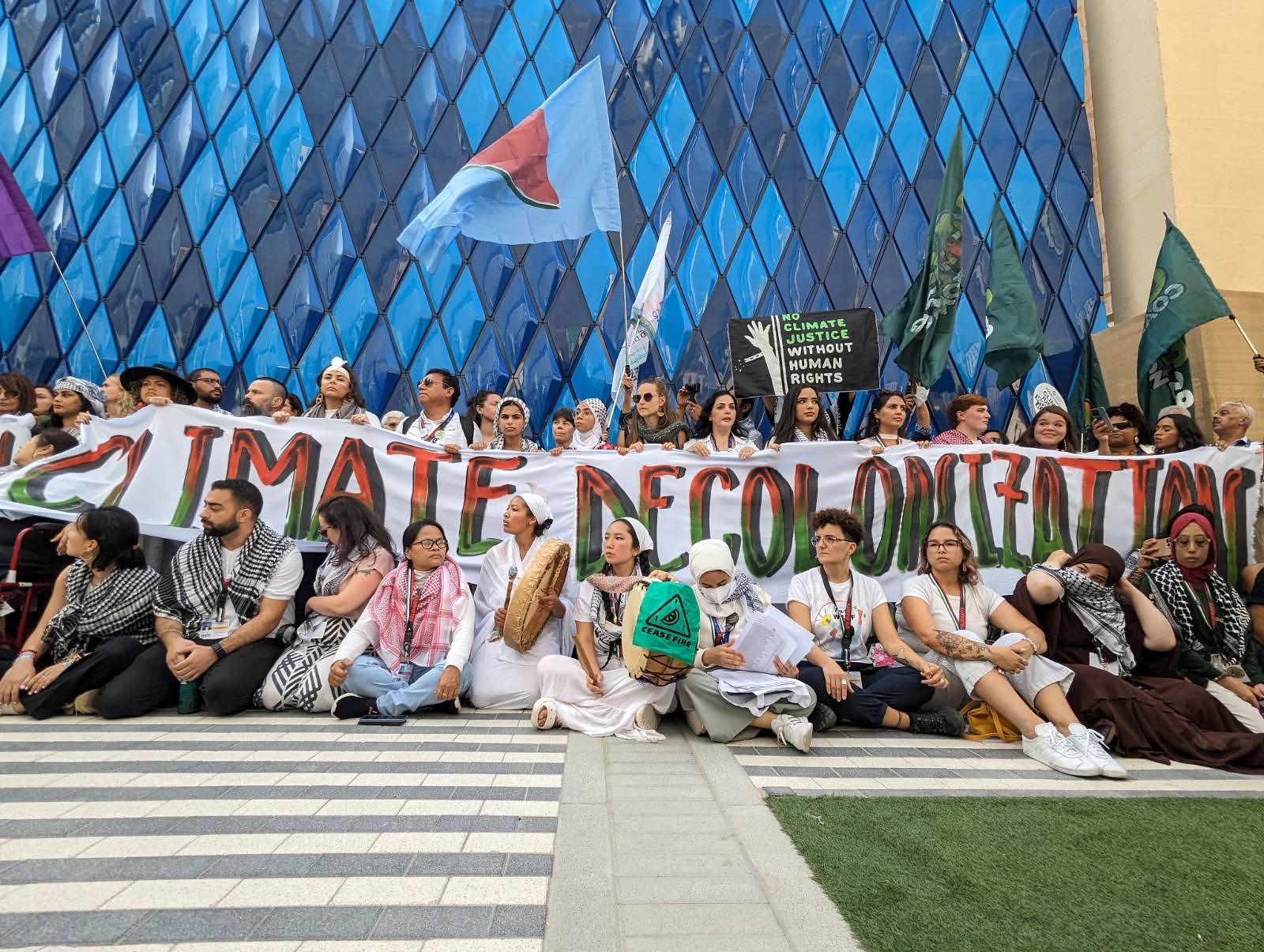The United States is in the midst of an orchestrated crisis and crumbling democracy, with white Christian nationalists using the overturning of the right to an abortion as tool. Following an unprecedented leak of a draft decision, for the first time in history, the nation’s Supreme Court justices have ruled to rescind a right deeply held by the American people. In doing so, they are speeding up the fall of dominoes to decimate the long-held separation of church and state and fast-tracking the criminalization of Black and a Brown pregnant people across the nation.
Following the legalization of abortion in four states, the Supreme Court of the United States recognized a constitutional right to abortion in January 1973. Ruling in the Roe v. Wade case, the High Court nationally legalized the procedure through the second trimester and invalidated hundreds of laws criminalizing the procedure. After Roe, the anti-abortion movement sought the political power to both undermine this right and make it physically and financially unattainable. Through a series of laws, politicians enacted restrictions; first by banning the federal health insurance coverage of the procedure for low-income Americans, then by making abortion difficult to offer. While the 1992 Supreme Court case Planned Parenthood v. Casey reaffirmed the right to terminate a pregnancy, that decision held that a state could restrict abortion in ways that reflect the state’s preference for childbirth using coercive tactics and medically inaccurate information. Ironically, while this decision allowed a state to use its power and taxpayer dollars to promote its preference, it did not correspondingly require states to fund the ramifications of that preference–the myriad costs associated with having a child.
Once the Supreme Court gave the signal that states could enact limitations to inhibit people from obtaining abortions, politicians passed thousands of such restrictions, which became the basis for ongoing litigation. Some of these laws were upheld and others were stuck down, all the while making abortion less accessible and more socially, medically, and legally stigmatized. Most recently, the courts allowed Texas’s ban on abortions after six weeks of pregnancy to be enforced by vigilante citizens who could collect up to $10,000 USD as a prize for turning in anyone who performed or assisted someone to obtain an abortion after the state’s legal limit.
These modern efforts to restrict abortion mirror earlier efforts in the 1900s when abortion was first criminalized in the U.S. That effort, led by the American Medical Association sought to increase the birth rate among white, Anglo Saxon protestant women as part of a national panic about “racial suicide” in the wake of increased immigration from southern Europe. Just as before, the current goal of restricting abortion is to regain control of the nation’s population through coercion, misogyny, and cruelty.
In June 2022, following an aggressive 50-year effort by the anti-abortion movement, the Supreme Court overturned its own Roe and Casey precedents—an unheard of tactic to rescind rights—allowing individual states to criminalize abortion for people residing within their borders. Immediately, several states returned to their pre-Roe laws. Many of these so-called trigger laws were still on the books from the mid- to late-1800s, when the people impacted by them weren’t even considered full human beings.
In the days after the ruling, other states rushed to ban abortion and criminalize anyone who “aids and abets” someone seeking to end a pregnancy. Within the year, we can expect half of the United States to criminalize.
Anyone who wants to end their pregnancy must either travel to a state where abortion remains legal or access the means to self-manage their abortion. Those who are unable to achieve one of these options will be forced to continue their pregnancies and have a child. Research shows most women will opt to parent those children while struggling at the margins of the economy. Whichever path people take, their options and outcomes will be shaped by the ongoing lineage of America’s original sin—slavery—and the ultimate goal of white supremacy and American dominance.

The United States was built on exploitation of Black and Brown bodies for profit, labor, and medical experimentation. White enslavers raped, bred, and sold enslaved Black women and their children. The children of Indigenous communities were forcibly removed and rehomed with white populations as part of a genocidal project. The history and prestige of American medicine is a result of the exploration of women of color. J. Marion Sims, an originator of American Gynecology, bought enslaved Black women whom he reportedly forcibly impregnated for his experiments. He believed that Black women were subhuman and could not feel pain, and thus he conducted surgery on them repeatedly without anesthesia. Later in the 20th century, pharmaceutical companies deliberately chose Puerto Rican women for medical trials of early birth control pills because their fertility was seen as disposable. The high dosages of hormones used in these clinical trials left an entire generation reproductively impaired. The cruel irony is that despite being the test subjects for these pioneering medical inventions, currently Black and Brown communities have some of the lowest access to contraception, gynecological care, and pre- and post-natal care.
So, it should come as no shock that Black and Brown women disproportionately experience the negative consequences of abortion criminalization. Over half of all abortions are to people of color, and Black women access abortion care at three times the rate of white women, a reflection of America’s deep-rooted racism and xenophobia. The higher need for abortion is the byproduct of lack of access to health care generally. When health care can be accessed, it is accompanied by medical racism, which begins in medical school. In the case of abortion, access to care is specifically restricted through federal and state laws that affect how abortion is paid for.
The U.S. does not have a national health care system, opting for loosely regulated privatized health insurance plans that make profits from denying payment for medical services. Health care bills are a leading cause of bankruptcy in the U.S. If they have insurance at all, people of color are more likely to have coverage under a federal health insurance system known as Medicaid that provides limited coverage to low-income individuals and is prohibited by law from covering abortion. Research finds that the cost of an abortion can be equivalent to a month’s income, and that to pay for abortion people use funds that should pay for rent, electrical bills, and child rearing expenses.
Abortion access in the U.S. is also limited based on geography in ways that disproportionately affect people of color. Since the 1970s, separate specialty clinics that offer only or mostly abortion services have been the main providers of abortion care in the U.S.; fewer than 2% of abortions happen in doctor’s offices. These clinics are primarily in urban centers, leaving one-third of all people nationwide living in a county (how states are divided) without a clinic. When all the abortion bans are implemented, abortion will not be available in any state in the American South, home to more than 50% of the country’s Black population.
Traveling to another state to access care will not be easy. For example, the one-way distance between New Orleans, Louisiana (a city whose population is 60% Black) to the closest open clinic in southern Illinois is almost 1000 km. In the U.S. there is no national rail or bus system, and airline tickets are expensive. But, even when support organizations exist to help with travel, it is made difficult by other lived realities. Over 60% of people who have abortions in the U.S. already have children and cannot simply leave them to travel. The U.S. lacks subsidized childcare, and there is no national paid or sick leave coverage. People of color are less likely to have employer-sponsored paid leave. Thus, time away from work reduces the actual money brought into the family. Further many forms of transportation in the U.S require legal identification, which undocumented immigrants to the country do not have. States committed to stopping abortion are trying to pass laws that prohibit people from traveling to states where abortion is legal and allowing them to be prosecuted as soon as they return home.
For those unable to travel and obtain care, some will seek to end their own pregnancy. In the years before the Roe decision, many women engaged in the same behavior, often significantly harming their health and, in some cases, causing death. In the years since, the option to end a pregnancy using the pharmaceuticals misoprostol with and without mifepristone have altered the landscape of unsafe self-managed abortion. These drugs are available in the U.S. where abortion is legal and prior to the overturning of Roe, more than 50% of all abortions were performed with medications. In states where abortion is banned, people will self-source their medications form international providers or radical activist networks. Performing an abortion in this way is medically safe and endorsed by the World Health Organization.
But the practice is not legally safe, and people who managed their own abortions may encounter a criminal justice system built with the intention of incarcerating as many Black and Brown people as possible. People living in predominantly Black and Brown neighborhoods are more likely to encounter police, as surveillance is common and their behavior scrutinized more closely. For example, although drug use in the U.S. is similar for whites and Blacks, arrests for drug possession are not. Blacks are significantly more likely to be serving criminal sentences for small drug possession offenses. Although the rates of incarceration are lower for women overall, Black women are twice as likely to be incarcerated as their white counterparts, and tribal girls are four times as likely to be incarcerated as white girls. Encounters with the criminal justice system are a leading cause of inability to complete secondary education.
In addition to being legally risky to source medications with which to self-manage an abortion, people of color and low-income people face many logistical barriers to such activity. Information is difficult to find as abortion opponents deliberately advertise false and misleading information about how to obtain an abortion. Research finds that encountering these fake entities reduces people’s ability to access a desired abortion. As with an abortion from a health care facility, acquiring medications also costs money, although about one-third the cost of an abortion provided by a clinic. Even a low cost is still a barrier to many people. Transferring needed funds to the supplier requires a form of electronic currency, which many low-income people do not have. When unable to find a safe way to end their pregnancy some people will turn to the use of harmful methods in some cases leading to death. Evidence from Texas, where abortion was severely restricted before the overturning of Roe, suggests most people will use safe options to manage their own abortions.
People who cannot obtain a desired abortion, either by traveling out of state or self-managing their abortion, will be forced to continue that pregnancy to term and delivery a baby. The consequences for the individual are significant. A ten-year research project named the Turn Away Study followed women who were denied a wanted abortion and found more bankruptcies and evictions as well as greater poverty for these women than for those who obtained a wanted abortion. These women were also more likely to stay with a violent partner and raise children without partner support. Not receiving a wanted abortion also had negative consequences for the children the woman already had, the child they had unexpectedly, and future children born into the family. Finally, women denied an abortion were also more likely to suffer long-term health consequences such as high blood pressure and migraines
Childbirth carries significant medical risk including a 14 times increased risk of dying. Compared to other developed nations, the chances of dying in childbirth are more than double in the U.S. The number is even more outrageous for Black women whose rate is twice as high. One study estimated that abortion bans in the U.S. will result in increases in maternal mortality in the first year by 7%, and that number will increase 21% in subsequent years. Non-Hispanic Black people would experience the greatest increase in deaths (a 33% increase in subsequent years). As most people who have abortions already have children, these deaths will leave existing children without a parent–hardly the pro-life outcome abortion opponents tout.
“Pro-life” legislators are lackadaisical in their responses and generally uninterested in addressing the root causes of the issue of the impact of abortion bans. The states with the most restrictive abortion laws also happen to be the same ones with little to no science-based sexual health education, widest racial wealth disparities, the highest rates of maternal mortality, with Louisiana as the worst. Coupled with the high maternal mortality rates, Louisiana has some of the most restrictive abortion bans pushed by anti-abortion politicians in both parties. But, there’s not much interest in figuring out why Black people are dying in pregnancy. When asked about it in an interview with POLITICO, Louisiana’s Senator Bill Cassidy responded, “For whatever reason, people of color have a higher incidence of maternal mortality.” He suggests an adjustment of the maternal morbidity numbers to correct for race, which would show the issue is not as it seems. Black people are about third of the population in Louisiana. Senator Cassidy, a trained physician specializing in gastroenterology, told NPR that systemic racism was “rhetoric” and that by looking at the science the “physiology” of Black people may play a role in disproportionate health disparities.
* * *
The impact of banning of abortion goes beyond just the people who seek to end a pregnancy. It has implications for all people capable of becoming pregnant and needing medical care. Core to the enforcement of abortion bans is the threat of imprisonment and even the death penalty for anyone who performs an abortion. This will not only make abortion inaccessible to their entire state populations, but further tie the hands of medical providers who may need to offer the procedure to patients whose pregnancies threaten their health or life. This is where the criminalization becomes real, and it is simply bad medicine.
As Dr. Jamila Perritt, the President of Physicians for Reproductive Health and fellow of the American College of Obstetricians and Gynecologists, described in an interview with us, the intersection of carceral logic and health care are completely antithetical to one another. It’s not possible to provide medical care in an environment where there is a threat—or reality—of carceral prosecution. Only in abortion care is the risk of criminalization so high, and providers are forced to question whether the care they are offering patients could send them to jail, which is especially complicated in high-risk pregnancy situations. “The last thing that you want when you’re seeking care is for someone to second guess what they’re doing. And by second guess, I mean guessing in the sense that I know that this is the best thing for the person that I’m taking care of but is this the best thing for me?” she explains. “The outcomes for the person that we’re caring for, and the provider that’s providing care should not should never be misaligned.”
Dr. Perritt told us this creates a break in the sacred provider-patient bond and creates situations in which providers and patients may be forced to turn on one another to act as surveillance for the state. “What we know for sure is that in any situation when healthcare providers are asked or forced to become agents of the state, it absolutely keeps people from care.” With the criminalization of abortion, providers are barred from helping their patients, and in some cases, believe it is their role to turn patients who may seek help after receiving illegal care over to police or inform police of actions a patient may have taken that could have affected the outcome of their pregnancy. “It means that our public health, our individual and community health, is compromised, because when people need to see health care providers, they don’t because of a fear of prosecution, because of a fear of intimidation, interrogation and of criminalization.”
* * *
The criminalization of pregnancy, however, is not unique to abortion. Few people realize how many rights and freedoms a person loses to their own body as soon as they become pregnant. In her book, Policing the Womb: Invisible Women and the Criminalization of Motherhood, legal scholar Michele Goodwin details dozens of cases of women who were arrested and jailed for actions perceived by the state to have negatively impacted the outcomes of their pregnancies. These include refusing medical interventions such as a cesarean section or having a miscarriage under “questionable” circumstances. While these women weren’t exclusively all Black and Brown—criminalization impacts low-income folks of all races—the policing disproportionately bears on those communities due to already heightened suspicions based on racist assumptions.
Vilification of Black pregnant women has always been the strategy of the anti-abortion movement. In 2011, infamous anti-abortion billboards declared “the most dangerous place for an African American is in the womb” insinuating that the most dangerous person to Black children is their own mothers. This messaging allows anti-abortion politicians to justify their open hatred of people who have abortions—the majority of whom are people of color, living in poverty, and already parenting—without claiming to be racist, misogynistic, or anti-family because they separate people who have abortions from the “good mothers” and those who are worthy of support. The stereotype, illustrates Dorothy Roberts professor of law and sociology at University of Pennsylvania and author of Killing the Black Body and Torn Apart: How the Child Welfare System Destroys Black Families—and How Abolition Can Build a Safer World, is one so powerful and dominant in U.S. culture, that it is what allows the government to so easily remove children from Black homes for the most minor infractions that could be easily solved with more money, food, and health care. Having children in poverty is a cause for investigation. Couple this with the fact that most people who have abortions are already parenting and seek abortions because they are unable to afford another child, anti-abortion bills create more people subject to state custody.
Wealthier white families will likely not face the same consequences. While some may face arrests or lawsuits for helping people who have abortions or self-managing their own, they simply will not be subject to the monitoring eyes of the state in the same way. They will not fear the immigration checkpoints as they cross state lines to obtain an abortion. Doctors and police are less likely to use their waffling over what to do about a pregnancy as evidence in a case about their stillbirth or miscarriage. And they’re less likely to be subjected to the child welfare system that Black and Brown people have been experiencing for so long.
One aspect overlooked in the discussions about the criminalization of abortion, Roberts says, is what happens to people who are charged with such accusations. For the women who have already been arrested and charged for allegedly self-managing their abortions, or not believed when they had stillbirths, their lives do not get to go back to normal. If they are not incarcerated, which is an automatic loss of bodily autonomy and freedom, and separation from their children, their lives are shattered. Their names have been splashed across headlines around the country. They may still have misdemeanors and felonies on their records and unable to find work or a place to live. They may have been ostracized from their families and communities, and their children may experience bullying. The mental health toll arrests take on them and their children is incalculable. Arguably, most impactful of all, is that in the aftermath of their decision to have an abortion, a decision made to be able to provide better care for the children they already have, the state may elect to remove their other children from their custody, tearing their families apart.
For those not caught up in the system, the societal control and fear still bears weight. “There’s the message it sends to other women that if you try to get an abortion, you’re at risk of being charged,” says Roberts. “Even the accusation itself has a damaging impact on people.”
The state will use disparaging stereotypes of “bad moms who have abortions” against many women to justify removing their children after they are unable to obtain the abortion they desired and are forced to carry their pregnancies to term. Roberts says these parents face a very painful conundrum because of the abortion bans. They were denied the abortion they wanted, then, while trying to live in poverty, they’re criminalized for not having access to basic human rights the government should be providing, and the government forces them to relinquish the children it forced them to have. Through the removal of their children, the parents face incarceration and live under legal control of the state and their children are placed in the underfunded child welfare system, and the cycle continues. They are punished for not having enough money to have children in the first place.
Roberts says this is overall the goal; the government’s “coercion into being the kind of citizen the state wants you to be which is based on white supremacist, patriarchal view of what citizens and families should be like.” Everything is being redefined in this moment—that’s why education access, reproductive justice, trans people and queer families, and Black communities are under simultaneous threat. By overturning Roe, conservatives are working strenuously to rebuild the nation in their white nationalist Christian vision, and they will stop at nothing to criminalize those who do not comply.
Renee Bracey Sherman, MPA is a reproductive justice activist, abortion storyteller, and writer. She is the founder and executive director of We Testify, an organization dedicated to the leadership and representation of people who have abortions and the co-author of the forthcoming book COUNTERING ABORTIONSPLAINING from Amistad/Harper Collins.
Tracy Weitz, PhD, MPA is a Professor of Sociology and Director of the Center for Health, Risk, and Society at American University. She is a leading expert on abortion in the U.S. and her research has led to positive state level policies and clinical practice innovations.



